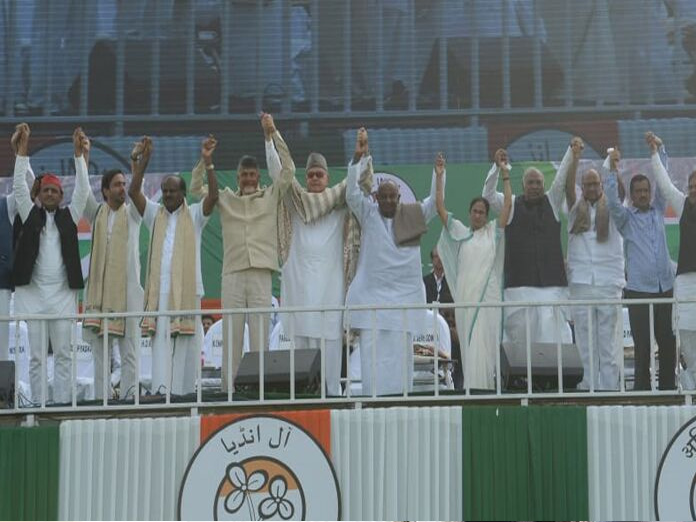A coalition again at the Centre this summer?

If the opinion polls are to be believed, India is heading for another period of coalitionsThe reason is that the next general election is expected to produce a hung Parliament, where neither of the two major contenders the Bharatiya Janata Party BJP and its opponents will be able to secure a majority
If the opinion polls are to be believed, India is heading for another period of coalitions. The reason is that the next general election is expected to produce a ‘hung’ Parliament, where neither of the two major contenders - the Bharatiya Janata Party (BJP) and its opponents - will be able to secure a majority.
Conventional wisdom also points in that direction because it is difficult to believe that a ruling party which is palpably far less popular than what it was even a couple of years ago will be able to repeat its performance of 2014.
Neither will the combine led by it - the National Democratic Alliance (NDA) - because the erosion of the government's popularity will drag down its allies as well. If the NDA cannot cross the halfway mark of 272 seats in Parliament, neither will its opponents - not even collectively, let alone singly.
For a start, their hope of fielding one candidate from among them against the BJP in every constituency has been dashed by their failure to act unitedly in several States. For instance, the Congress could not align with the Bahujan Samaj Party (BSP) in any of the three recent Assembly elections.
Nor was it possible for the Samajwadi Party-BSP combine to reach an understanding with the Congress for the 80 parliamentary seats in UP. These rifts show that the Opposition will approach the general election as a divided house in nearly all the States except perhaps in Maharashtra, where the Congress has reached an understanding with the Nationalist Congress Party (NCP) for the State's 48 parliamentary seats.
The BJP will expect this disarray among its adversaries to benefit it, but the NDA's own condition doesn't give much hope. For one, some of its allies like the Telugu Desam and the Rashtriya Lok Samta Party have already walked into the opposition camp.
For another, the BJP had to bend over backwards to keep restive partners like the Janata Dal (United) and the Lok Janashakti Party in tow. They will become even more assertive if the NDA doesn't get a majority and the BJP becomes more dependent on them. For a third, there is still no certainty that the BJP and the Shiv Sena will end their constant bickering and fight the elections together.
What these ruptures within the two opposing sides suggest is how difficult it will be for them to forge a viable unity after the elections in the event of their falling short of a majority. True, India hasn't been a stranger to coalitions either at the Centre or in the States. Ever since the diminution of the Congress's pre-eminent position from the 1960s, coalitions have been the order of the day.
Some of them. like the Left Democratic Front and the United Democratic Front in Kerala have succeeded in maintaining their unity and rule effectively, usually in alternate five-year terms. The Centre, too, saw successful coalitions in the post-1990 scenario with Atal Behari Vajpayee's mammoth 24-party alliance providing a sterling example of togetherness.
Will a fractured mandate throw up a similar example of bonhomie or will it revive the worst fears about ruling alliances with each constituent constantly sniping at the others?
The BJP's current propaganda is based on depicting such a scenario about its successors with the party chief, Amit Shah, saying that the scene will be so chaotic that each day of the week will see a new Prime Minister.
Among these claimants will be Rahul Gandhi, whose name has already been proposed by Karnataka Chief Minister HD Kumaraswamy and the DMK president MK Stalin. Conjectures in the political grapevine have mentioned Mamata Banerjee and Mayawati as the two others. But much will depend on how many seats their parties will get.
One of the reasons why the West Bengal Chief Minister wants her party to contest not only the 42 seats in the State, but also venture into 14 other States is to shore up her party's numbers, especially in view of the serious challenge which she is facing from the BJP in West Bengal.
Similarly, Mayawati's decision to field her candidates in 38 seats in UP is based on the need for numbers. She is also likely to set up candidates in several other States as well.
Even as the BJP draws some satisfaction from the generally self-serving strategies of the PM wannabes in the ‘secular’ camp, there is also speculation about the BJP's future if it fails to get a majority - notwithstanding its slogan of "abki baar, 400 par" - since questions are bound to rise about Narendra Modi's continuance as the PM if only because the entire responsibility for a setback will be attributed to him even more than to his Man Friday, Amit Shah.
It is in this context that some of Union Minister Nitin Gadkari's kinder, gentler comments have been interpreted as an attempt to position himself as a successor who can get along with the allies. There will be a scramble, therefore, for partners - cutting across party lines - if there is a "hung" Parliament.







